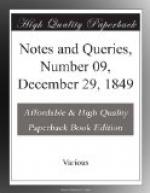Mr. Stewart can scarcely suppose to have seen the book upon which he pronounces this most “unwarranted” criticism. The tract was not written in reply to the Characteristics, but was an answer to an anonymous letter published in the Daily Post-Boy of September 9th, 1732, which letter Berkeley has reprinted at the end of his pamphlet. The only allusion to the writer of this letter which bears the slightest tinge of severity occurs at the commencement of the tract. Those who will take the trouble of perusing the anonymous letter, will see that it was richly deserved; and I think it can scarcely, with any justice, be censured as unbecomingly harsh, or in any degree unwarranted. The passage is as follows:—
[After mentioning that an ill state of health had prevented his noticing this letter sooner, the author adds,] “This would have altogether excused me from a controversy upon points either personal or purely speculative, or from entering the lists of the declaimers, whom I leave to the triumph of their own passions. And indeed, to one of this character, who contradicts himself and misrepresents me, what answer can be made more than to desire his readers not to take his word for what I say, but to use their own eyes, read, examine, and judge for themselves? And to their common sense I appeal.”
The remainder of the tract is occupied with a philosophical discussion of the subject of debate, in a style as cool and as free from harshness as Dugald Stewart could desire, and containing, as far as I can see, nothing inconsistent with the character of him, who was described by his contemporaries as the possessor of “every virtue under heaven.”
James H. Todd.
Trin. Coll. Dublin, Dec. 20. 1849.
* * * * *
Bishop Barnaby.
Mr. Editor,—Allow me, in addition to the Note inserted in your 4th Number, in answer to the Query of LEGOUR, by your correspondent (and I believe my friend) J.G., to give the following extract from Forby’s Vocabulary of East Anglia:—
“Bishop Barnabee-s. The pretty insect more generally called the Lady-bird, or May-bug. It is one of those highly favoured among God’s harmless creatures which superstition protects from wanton injury. Some obscurity seems to hang over this popular name {132} of it. It has certainly no more relation to the companion of St. Paul than to drunken Barnaby, though some have supposed it has. It is sometimes called Bishop Benebee, which may possibly have been intended to mean the blessed bee; sometimes Bishop Benetree, of which it seems not possible to make any thing. The name has most probably been derived from the Barn-Bishop; whether in scorn of that silly and profane mockery, or in pious commemoration of it, must depend on the time of its adoption, before or since the Reformation; and




